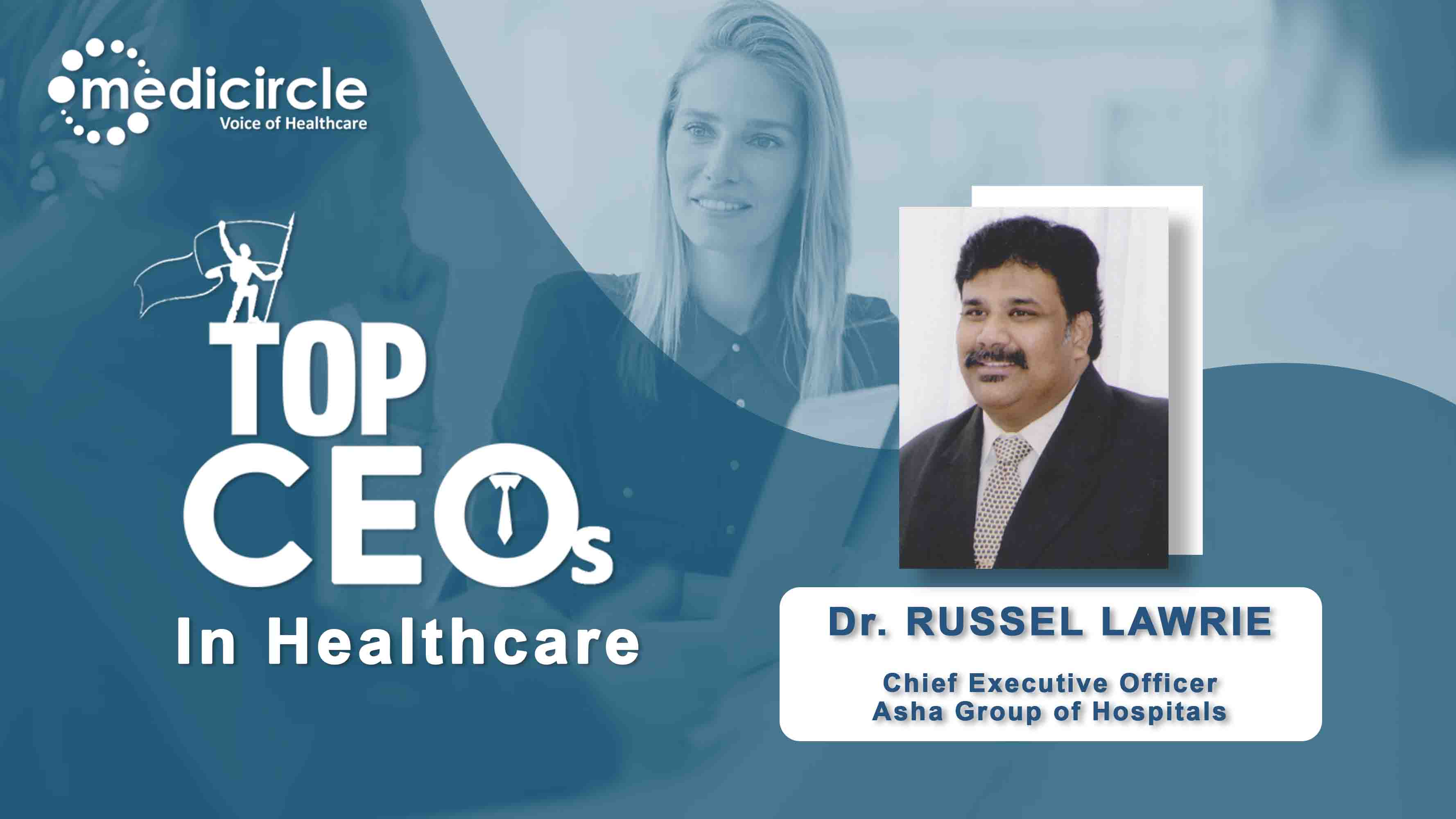After the global community was impacted by a severe pandemic, the importance of healthcare and the healthcare technology field is felt more than ever before. In recent years, healthcare has become an integral part of the business ecosystem in India. While healthcare itself is a noble profession and majorly contributes to humanity. Successful healthcare entrepreneurs are making a valuable contribution to the national economies around the world. Medicircle presents top CEOs of the healthcare series where we are featuring healthcare CEOs who are influential role models to share the views about the future of the healthcare industry.
Dr. Russel Lawrie is the CEO of Asha Group of Hospitals, Nagpur. He had been associated with Sevenstar Hospital, Meditrina Institute of Medical Science in the past. He has a rich experience of working in Pharmaceutical Industries also. He is a Doctorate in Management Studies with a thesis being on Operations and Healthcare marketing. Adding to this Dr. Russel has done Masters in Hospital Administration. Deploying the principles of management coupled with accrued working and practical experience spanning over 25 years of duration, he has achieved many milestones.
Awareness is also one of the major challenges of the Healthcare Industry
Dr. Russel says, “If you ask me about the major challenges of the healthcare industry, I would like to add one more challenge “awareness” to the rest three that has already existed, affordability, availability, and accessibility. I have associated with hospitals across various demographics. I have come to believe that “one size fits all,” doesn’t practically fit for all hospitals demographically. Every hospital would need tailor-made strategies to be in place by thorough professionals if it is to actually cater to its masses or even achieve its commercial goals. Low and moderate income patients are able to secure aptly, affordable and adequate coverage by medical insurance policy and establishment of permanent reassurance program by govt.”
Dr. Russel tells, “In health care, the days of business as usual are over. Around the world, every health care system is struggling with rising costs and uneven quality, despite the hard work of well-intentioned and well-trained clinicians. Health care leaders and policymakers have tried countless incremental fixes, attacking fraud, reducing errors, enforcing practice guidelines, making patients better ‘consumers’, implementing electronic medical records but none have had impacted much.”
Value for Patients
Dr. Russel expresses, “It’s time for a fundamentally new strategy. At its core in maximizing value for patients which means achieving the best outcomes at the lowest cost, that is ‘More and More with Less and Less’. We must shift the focus from the volume and profitability of services provided, physician visits, hospitalizations, procedures, and tests to the patient outcomes achieved.”
Dr. Russel states, “Making this transformation is not a single step but an overarching strategy. It will require restructuring how health care delivery is organized, measured, and reimbursed. The first step in solving any problem is to define the proper goal. Narrow goals such as improving access to care, containing costs, and boosting profits have been a distraction. Access to poor care is not the objective, nor is reducing cost at the expense of quality. Increasing profits is today misaligned with the interests of patients because profits depend on increasing the volume of services, not delivering good results. In health care, the overarching goal for providers, as well as for every other stakeholder, must be improving value for patients, where value is defined as the health outcomes achieved that matter to patients relative to the cost of achieving those outcomes.”
Magical Journey so far
Dr. Russel speaks, “well my journey in the Healthcare Industry spanning over 25 years now has not been anything less than a ‘roller coaster ride,’ with many ups and downs. Healthcare careers are rewarding and fulfilling. Healthcare workers spend each day making a difference in the lives of others, whether it's caring for patients as they recover, assisting a family through a difficult medical situation, or working behind the scenes to keep a medical facility running smoothly.”
Dr. Russel adds, “They say ‘change’ is the only constant. Based on this fact, I have been constantly reviewing situations, circumstances, and scenarios throughout my journey in the healthcare industry. This could be possible owing to the solid education background that I possess.”
Limitations of Indian Healthcare and its Solutions
Dr. Russel talks about past and present limitations of Indian Healthcare as:
“The limitation of infrastructure - Earlier there was an almost complete dominance of public healthcare in the medical landscape of India. After some time, there were private corporate houses in the healthcare scenario which was perceived to be expensive. Strategies had to be devised to combat perception. The limitation of access - Access to healthcare was a huge challenge. But today lot many business houses, private players foraying into the healthcare industry. This has spurred the public sector undertakings to ‘up’ their mettle, thus bridging the gap to some extent. The limitation of affordability - This aspect of affordability to a great extent has been taken care of with the government healthcare schemes like the Ayushman Bharat, PMJAY, MJPJAY, MPKAY, and sorts. With the development of roadway and railway infrastructure, a person from hinterlands can now access quality healthcare solutions. The limitation of quality & research - The common understanding was that if you wanted quality healthcare, you have to make a trip overseas. The research was the largely ignored area, as there was simply no time and resource dedicated to research. It was an uphill task and even now to some extent. Promoters should understand the genuine benefits that quality would bring to clinical efficacy, as well as to the commercial side. The limitation of manpower - Even today, it is a multitasking endeavor. For example, a staff taken as a driver could well double up as an OT attendant, ward boy with not even basic schooling could easily double up as a floor supervisor or a person taken as a ‘help’ around the hospital facility could easily double up as front office coordinator. The limitation to reverse the demand - The long-term benefits of managing the demand of healthcare, through preventive healthcare, comprehensive immunization, etc. were largely ignored. Strategizing to keeping patients engaged, or to seek new patients to patronize the hospital and to make a genuine perception is an uphill task that one faces even today.”
Changes in the Healthcare post COVID
Dr. Russel mentions, “From supply chain to technology innovations, I believe there would be four ways healthcare will change in the long term as a result of the COVID-19 pandemic that is:
New strategies for elective surgeries - Patients who have put off elective surgeries and procedures will need to be reassured that it’s safe to enter hospitals and other healthcare facilities. Health systems are struggling with developing the right approach to engage patients and make them feel safe.
Developing local supply chain sources - The COVID-19 pandemic exposed critical flaws in hospital supply chains for vital equipment like PPE. Many health systems struggled with shortages and often competed with each other for necessary supplies. It would be a good idea if more hospitals talk about creating a consortium and building some domestic manufacturing of PPE locally to reduce their reliance on importing.
Digital health options will accelerate - The COVID-19 pandemic has put the spotlight on digital health tools like telehealth and remote monitoring. Healthcare providers had to quickly pivot to technology to take care of patients. Digital health has gone from a "nice to have" to a “must have.” Innovations in the area of at-home diagnostic equipment will further enhance the ability of providers to do remote virtual care.
Expect innovations with drones and robotics - The biggest impact of the COVID-19 pandemic has been on how consumers work and live with social distancing measures and working from home. With that in mind, there will be advancements in drones and robotics in the consumer world to reduce the number of people who interact with other people, if not immediately then in the near future.”
A valuable piece of advice
Dr. Russel informs, “India’s overall spending on the health sector is low. It has been coming from constrained resources, with many competing priorities. Citing the National Health Mission (NHM) document, India’s expenditure on the health sector should be to the tune of 3% by 2025. We all need to raise our voices to both the Union and State Governments to enhance the expenditure on the healthcare sector along with adopting ways to increase healthcare infrastructure. As a result, the government may target the primary healthcare sector. The private sector should focus on the secondary and tertiary healthcare sector as there is a huge scope for expansion in these sectors.”
Dr. Russel updates, “The budget allocation for the Department of Health & Family Welfare surged from Rs 37,061 crore in FY17 to Rs 65,001 crore in FY21 that is about 3.6% of the GDP, and the government aims to raise the public health expenditure from 3.6 to 4.5 percent of GDP by 2025 in a time-bound manner. However, the expenditure budget on medical research has not increased significantly over the past few years. The expenditure budget for research was Rs 1727 crore in FY19, which has grown to Rs 2100 crore in FY21, according to the Budget documents.”
Dr. Russel advises, “With these changes in the disease demographics, and to tackle with such pandemic times going ahead, I think it’s high time India needs a generous amount of spending in the healthcare sector.”
(Edited by - Renu Gupta)

 “The COVID-19 pandemic has put the spotlight on digital health tools like telehealth and remote monitoring. Digital health has gone from a "nice to have" to a “must have.†Innovations in the area of at home diagnostic equipment will further enhance the ability to do remote virtual care.†Dr. Russel Lawrie, CEO of Asha Group of Hospitals.
“The COVID-19 pandemic has put the spotlight on digital health tools like telehealth and remote monitoring. Digital health has gone from a "nice to have" to a “must have.†Innovations in the area of at home diagnostic equipment will further enhance the ability to do remote virtual care.†Dr. Russel Lawrie, CEO of Asha Group of Hospitals.










.jpeg)

.jpeg)
.jpeg)
.jpeg)

.jpeg)
.jpeg)
.jpeg)
_(1).jpeg)

_(1)_(1)_(1).jpeg)
.jpeg)
.jpeg)
.jpeg)






